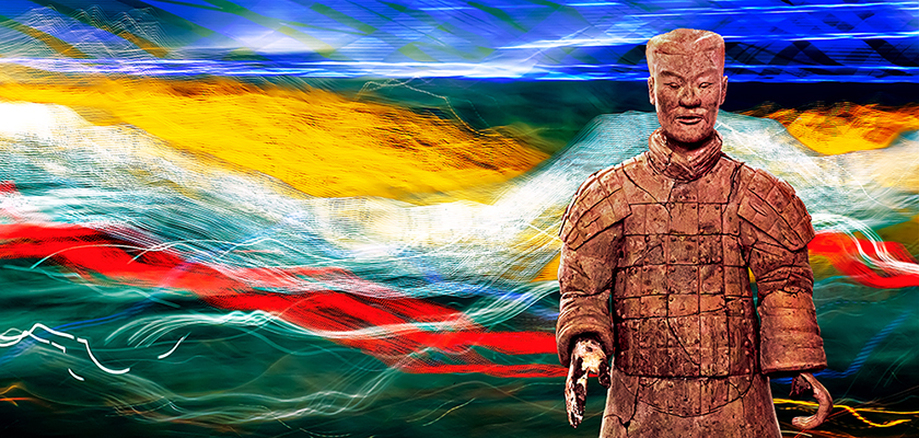China: Back to the Future

The exploration of duality is a common thread that frequently runs through my work. Perhaps that’s what intrigues me about China. After so many years of repression, the country has welcomed the 21st century with open arms and unabashedly embraced many aspects of western culture. However, the future collides with the past at every turn. A recent visit brought me face to face with both ancient and modern China and I’ve used my digital darkroom to create a mash-up of images that express this clash.
I chose the terracotta warriors, created in the late third century BC, to represent ancient Chinese culture. The remarkably life-like figures stare eerily ahead; their sightless eyes seem to contemplate the mysteries of the centuries. As part of the restoration process many of them are wrapped in protective plastic with numbers around their necks. They bear this indignity with stoic grace.
To convey the excitement and turbulence of modern life I photographed the colourful light displays that are so much a part of Chinese cities. Even the shabbiest neighbourhoods are radiant at night as they come alive with explosive bursts of colour. I wanted to create edgy images that pulsed with static energy so I used a very slow shutter speed while moving the camera in sweeping arcs. This produced dancing ribbons of boldly coloured light and science fiction landscapes suitable for time travel.
The photographs have been mounted on an aluminum substrate and coated with several layers of resin creating a vibrant, glossy finish reminiscent of the sophisticated Chinese lacquer process first developed during the Shang Dynasty (ca 1600 - 1046 BC).
Ancient China was in the forefront of technological development and creative thought. These contributions have shaped the course of history. Without these advancements the world would be a different place.
Perhaps the Chinese sage Lao Tzu summed it up best in the Daodejing:
"Attend the present to deal with the past: Thus you grasp the continuity of the Way, Which is its essence."
I chose the terracotta warriors, created in the late third century BC, to represent ancient Chinese culture. The remarkably life-like figures stare eerily ahead; their sightless eyes seem to contemplate the mysteries of the centuries. As part of the restoration process many of them are wrapped in protective plastic with numbers around their necks. They bear this indignity with stoic grace.
To convey the excitement and turbulence of modern life I photographed the colourful light displays that are so much a part of Chinese cities. Even the shabbiest neighbourhoods are radiant at night as they come alive with explosive bursts of colour. I wanted to create edgy images that pulsed with static energy so I used a very slow shutter speed while moving the camera in sweeping arcs. This produced dancing ribbons of boldly coloured light and science fiction landscapes suitable for time travel.
The photographs have been mounted on an aluminum substrate and coated with several layers of resin creating a vibrant, glossy finish reminiscent of the sophisticated Chinese lacquer process first developed during the Shang Dynasty (ca 1600 - 1046 BC).
Ancient China was in the forefront of technological development and creative thought. These contributions have shaped the course of history. Without these advancements the world would be a different place.
Perhaps the Chinese sage Lao Tzu summed it up best in the Daodejing:
"Attend the present to deal with the past: Thus you grasp the continuity of the Way, Which is its essence."